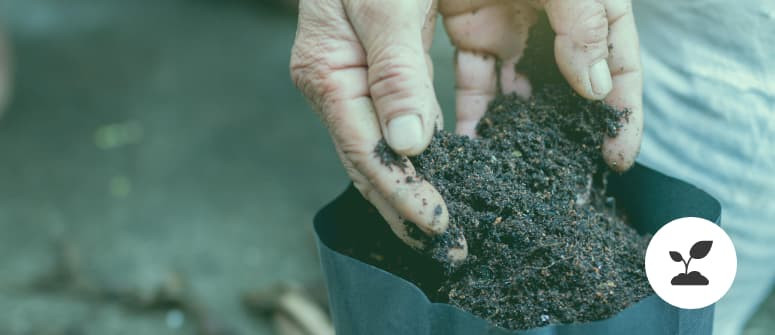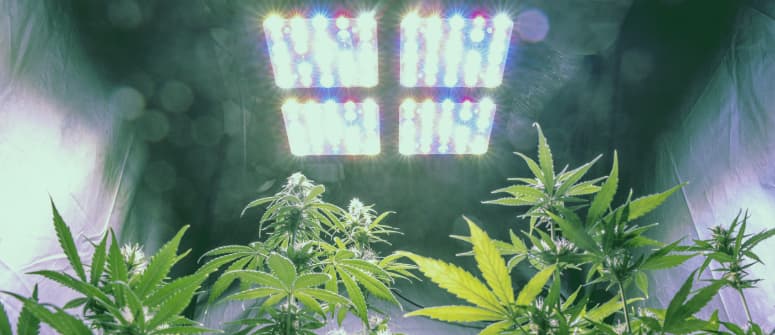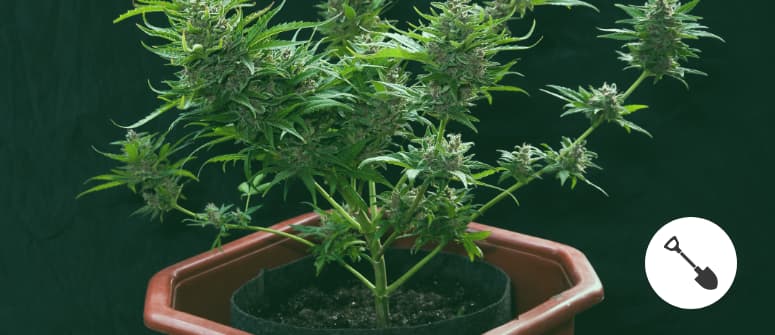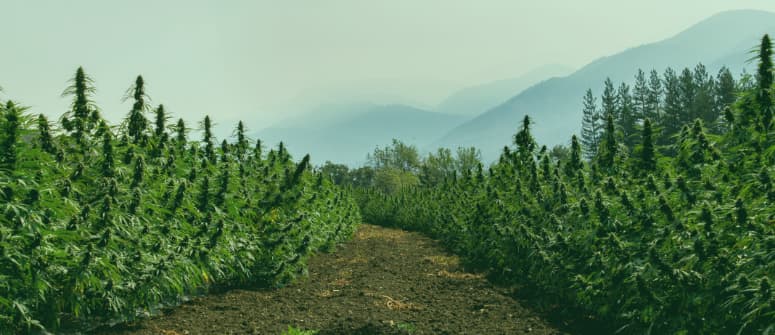Growing cannabis indoors in soil

For beginners looking to grow cannabis indoors, soil is the natural place to start. Offering reliability and incredible results, millions of years of evolution have paid off! Here we look into why soil is so good for cultivating weed, the different types of soil and customisations, and how to make your very own soil mix.
Contents:
- The basics of growing weed indoors in soil
- Pros and cons of growing cannabis indoors in soil
- What is the best soil for growing cannabis?
- Customisation to improve cannabis soil quality
- Making your own soil: beginner recipe
- Can indoor cannabis be grown outdoors?
- Growing indoors in soil: excellent for beginners
When you think of plants, it’s pretty difficult to not also think of soil. And if you’ve ever seriously thought about growing cannabis, it’s likely you’ve thought about growing it in a soil medium. Simple, easy, and cheap, soil is, for many, the preferred substrate in which to grow marijuana.
In the following guide, we'll take you through the ins and outs of growing weed indoors in soil, including the benefits and drawbacks, the different types of soil and amendments, and how to make your very own soil mix at home. Even if you've never grown weed indoors before, you can achieve success with little more than some cannabis seeds and soil.
The basics of growing weed indoors in soil
For pretty much all novice growers, and many advanced growers, soil is the medium of choice when it comes to cultivating a crop of cannabis. Though there are other methods—such as hydroponics—nature has tried and tested soil for millions upon millions of years, and it’s proved to be pretty reliable.
Good-quality soil comes packed with the nutrients necessary to get a cannabis seedling to burst out of its shell. Moreover, good soil is well-aerated, has good drainage, and is able to maintain a steady pH, allowing your plants’ roots to successfully absorb nutrients.
Upon setting out on your indoor grow, one of the first things you’ll need to do is choose a suitable pot size. Strain, growing technique, location, and grow space size will all determine the best container size for your operation. But remember; the bigger the pot, the bigger the plant! From here, you'll need some suitable grow lights, a ventilation system, and the soil itself.
Pros and cons of growing cannabis indoors in soil

Cultivating weed in soil can definitely be considered the simplest method. If the conditions are good, growing this way can be as easy as growing any other house plant—although the results will be more spectacular! Nevertheless, soil has a few disadvantages too.
Pros
- Forgiving: Soil acts as a great buffer, making issues with nutrients or pH easier to rectify, without causing significant damage to your plants.
- Hospitable environment: Soil is the cannabis plant’s natural habitat, and as such plants can thrive even in less-than-perfect conditions. Not only is it hospitable for cannabis roots, but also for beneficial microorganisms as well. Plant health and nutrient uptake can be boosted significantly by the presence of beneficial soil-dwelling bacteria and fungi.
- Simple: Though you can get very technical with a soil grow, it can also remain exceptionally simple.
- Portable (kind of): Though you don’t want to move them around too much, it is possible to shift pots about, allowing you to utilise your grow space to the best of your ability.
- Cheap (potentially): A soil setup can be extremely cheap.
- Good results: Due to the affinity between cannabis and soil, it’s not difficult to achieve satisfying results.
- Organic: It’s easy to keep a soil grow totally organic—if you want to.
Cons
- Pests: As well as being a hospitable home to plants and beneficial microbes, pests also thrive in soil. However, good-quality soil should come without any lingering pests, pathogens, or disease.
- Uses more water: Though it seems counterintuitive, soil grows actually use more water than super-optimised hydroponic grows.
- Runner-up to hydro?: Rumour has it that hydro grows can eke overall better results from weed plants than soil, though this is debated. Furthermore, unless you are experienced, it isn't worth the time and resources necessary to run a highly efficient hydro grow.
- Takes up space: Potted soil naturally takes up a lot of space, so you’ll need to devote sufficient room to your plants.
- Expensive: This isn’t really specific to a soil grow, but growing cannabis indoors can get expensive. LED lights, tents, fans, fertilisers… the list goes on. When setting up your grow, it’s important to choose the right equipment to save money.
Is indoor cannabis stronger or better than outdoor cannabis?
Most growers dream of cultivating exceptionally strong cannabis, and thus wonder which environment yields the best results.
There is no real consensus on whether indoor or outdoor cannabis is stronger in potency, as it really depends on how it’s grown. Outdoors, under the sun, growers benefit from the unmatched light (if the weather is good), which can, in turn, promote peak potency from your weed crop.
That being said, an indoor grow tends to offer a lot more control. Temperature, humidity, watering schedule: all of these things can be fine-tuned to deliver superb results. So, with a bit of effort and a good set of lights, super-strong cannabis can indeed be achieved indoors.
Ultimately, the quality and potency of indoor buds come down to environmental factors, the skill of the grower, whether any training techniques were used, and various other factors.
What is the best soil for growing cannabis?
When choosing a soil medium in which to grow your cannabis, there are some general qualities you need to look out for. Whichever soil mix you eventually opt for, it must feature the following traits for your grow to be successful:
- Loose texture: This allows for aeration and drainage, which are essential to the health of your cannabis plant’s root system.
- Water retention: This may seem to negate the first point, but it’s about finding balance. While you don’t want water to pool and become stagnant, enough needs to be retained that the substrate stays moist and humid.
- Slightly acidic pH level: The optimal pH level for cannabis grown in soil is between 6.0 and 7.0.
- Rich texture: You want your soil to be dark and rich, as opposed to light and sandy.
- Nutrients: Unless you’re creating your own super soil, you will at some point need to feed your cannabis plants. However, good-quality soil should come ready to feed your plants for the first 3–4 weeks.
Below, we break down the different types of soil you can use to mix a substrate for your cannabis plants. Each has benefits and drawbacks to be aware of, and again, balance is key.
Sandy soil
Sandy soil is coarse and has very good drainage—sometimes too good. As well as having poor water retention, it’s very easy to wash nutrients away when using sandy soil. On the other hand, aeration is good, and the risk of issues such as root rot is negligible. Plus, it has a naturally acidic pH.
Sandy soil is not a good option on its own, but it can be a viable ingredient in a soil mix. Mixing sandy soil with something like vermiculite, which helps to retain water, can improve it as a medium. More on this later.
Silty soil
Silty soil is a very good option, especially for beginners. Offering a rich mineral content, moderate–good drainage, and decent water retention, it can make a great home for your plants. So long as you’re not overenthusiastic with your watering and feeding, silty soil is a fantastic foundation for your substrate.
Loamy soil
This type of soil is ideal for cannabis and is perhaps the best option. Combining sand, silt, and clay soils, as well as added minerals and nutrients, it provides a near-perfect habitat for a plant’s roots. The downsides? It can be a little expensive.
Clay
Fine particles give this soil fairly poor drainage and aeration, making it quite hard to work with. So why include it on the list? The high natural mineral content makes it a very good ingredient for those who are serious about organic cannabis cultivation.
Customisation to improve cannabis soil quality

Unless you’ve splashed the cash and gone for a ready-made soil specifically designed with cannabis in mind, then it’s possible you’ll want to modify it a little before you get growing. The following amendments work to optimise the health of the roots in various ways, making for healthier plants and higher-quality yields to boot.
Worm castings
Using worm castings introduces a huge array of microorganisms into your soil, promoting healthy growth. Moreover, they improve drainage and aeration, which is ideal for growers working with more dense soil ingredients, such as clay.
Vermiculite
Vermiculite, though it looks like little beads of plastic, is actually an organic compound. Super light, it improves the water retention of your soil medium, helping to keep your plants hydrated.
Perlite
Perlite, much like vermiculite, is a very light organic compound. However, perlite improves aeration and drainage. Used in conjunction with vermiculite, perlite can help to achieve exactly the right amount of oxygen flowing through your soil.
Coco coir
Coco coir is made from the fibre of coconut husks. Also very light, it too improves water retention. Some growers even use coco coir as the main substrate, but this can be tricky and isn’t recommended for the novice.
Clay pebbles
Clay pebbles, depending on how they’re used, can help with drainage and water retention. Most commonly associated with hydroponic growing, they are actually handy in other media too.
Placed at the bottom of a pot, clay pebbles make for excellent drainage and stop water from pooling, thereby reducing the risk of root rot. Placed on the top, like mulch, they help to stop excess evaporation from the top of the soil, keeping moisture and humidity up. This is especially helpful if you’re growing beneath hot, high-powered lights.
Nutrients
Plants need food and water, just like us. Feeding protocol varies depending on the soil composition, strain, and stage of growth (seedling stage, vegetative stage, or flowering stage). However, good feeds will have instructions on how and when they’re best used, as well as recommended doses. When it comes to fertilising your soil in the first place, be sure to find out whether it already contains nutrients. If it’s potting soil, it probably does, and you definitely don’t want to add more nutrients to an already fertilised substrate.
How much and how often you water your plants also vary according to several factors. Chiefly, their needs will change based on their age and the size of their root system. At first, you just want to keep the soil moist and humid. As your plants ramp up growth and eventually begin flowering, they’ll get much thirstier. That said, you definitely don’t want to overwater. That’s one of the most common cannabis plant killers, especially among beginners.
A good rule of thumb: If the top few centimetres of soil is dry, then it’s a good time to water.
Watering and feeding your plants will affect the pH level in the soil, usually for the worse. So you’ll need to check pH, and potentially use a pH up/down solution to adjust levels back to where they need to be!
Making your own soil: beginner recipe
If you really want to get into weed cultivation, then making your own soil mix is highly rewarding, and will give you intricate knowledge of the growing process. In learning to understand the medium in which a plant grows, you'll naturally learn much more about the plant itself.
This process, though a little hands-on, is suitable for growers of all levels. It’s not complex, and offers great results. As you become a little more experienced, you can try out your own recipes and really try to perfect it. One day, you might even try to make an organic super soil.
What do you need?
The measurements below are given as proportions. First, you’ll need to figure out the overall amount of soil you’ll need, and then break it down into constituent parts. To make your own soil, you’ll need:
- 1 part vermiculite
- 1 part coco coir peat
- 2 parts compost
- ½–1 cup worm castings (or humus)
Directions
- To remove the chunky bits, sieve the compost. The finer and more evenly spread it is, the better.
- Now, soak the coco coir peat in warm water. The directions will tell you what the final volume will be.
- Mix the vermiculite with the soaked coco coir peat in a bucket.
- Add the compost and worm casting then mix it all together. Try to get an even spread.
How to test cannabis soil pH
Now that you’ve created your very own soil, you’re almost ready to start growing. But before you plant anything, you need to do a few final checks to ensure the pH is suitable.
Fortunately, pH meters exist, and they’re cheap. You can also use strips or drops, but these only test the pH of water. A pH meter will test both water and soil, so it’s a more versatile piece of equipment.
Make sure your pH meter is properly calibrated, then stick it in your soil mix and see what the reading is! At this stage, don’t cut corners. Optimising pH now will get your plant off to the best start, as a pH that is too high or low will prevent it from absorbing nutrients, leading to stunted growth or death. Using a pH up or down solution, adjust until it’s at the right level.
Can indoor cannabis be grown outdoors?

It certainly can. Many growers start seedlings off indoors, in a highly controlled environment and beneath lights, but move them outdoors once they’re a little more robust. Doing this means you can ensure they get through their first, fragile stage in good health, but can reap the full benefit of the sun in the summer season.
Another option is to grow cannabis in a greenhouse. If you have a suitable space, this can offer a perfect middle-ground. With control over water and even light (using an opaque tarpaulin), you can take the best parts of indoor and outdoor growing.
Growing indoors in soil: excellent for beginners
Growing in soil is a great option for indoor growers, especially beginners. Offering reliability, this forgiving medium is capable of yielding astounding results. Some of the best cultivators and breeders in the world use soil as their medium of choice. Not all professional grow spaces are super-high-tech hydro setups.
Whether online or in garden centres, there are plenty of places that sell soil with a perfect balance of nutrients, ready to house your marijuana plants. For total novices, this is a great option, as it means you can focus on growing your plants as opposed to fussing about soil.
However, for those who want to be a little more involved, making your own soil mix is also an option. Following the steps above, you can create a hospitable environment for your plants, with very little cost or effort. In time, you can use this method as a base on which to develop your own organic super soil mixtures.
Whichever way you choose to go, you can be sure that soil will be both your and your plants’ friend.
.jpg)
.jpg)

.jpg)
